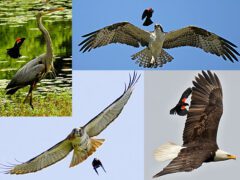The Four Keys to ID
- Size & Shape
A stocky, medium-sized songbird with short, notched tail and an unusual, twisted bill that crosses when closed.
Relative Size
Larger than a warbler, smaller than a Red-winged Blackbird, but there’s much size variation: the smallest types are barely larger than a Black-capped Chickadee, while the largest are larger than a Brown-headed Cowbird.

 sparrow-sized or smaller
sparrow-sized or smallerMeasurements
- Both Sexes
© Chris Wood / Macaulay Library
- Color Pattern
- Behavior
- Habitat
Regional Differences
Ornithologists have discovered that different crossbill populations, some of them previously defined as subspecies, have distinctly different flight calls and bill shapes that are adapted for different types of cones. They now term these different groups “types,” rather than subspecies. In some cases, these types behave like full species—that is, only breeding with others of their type. Scientists call this assortative mating. In 2015, the “type 9” Red Crossbill, known only from Idaho, was elevated to the status of full species, Cassia Crossbill. Studies are now focused on the degrees of difference between the other 10 North American (and more than a dozen Eurasian) types of Red Crossbill. It is possible that more types will become recognized as full species. Currently, field identification of a Red Crossbill type requires a recording of its flight call.

























